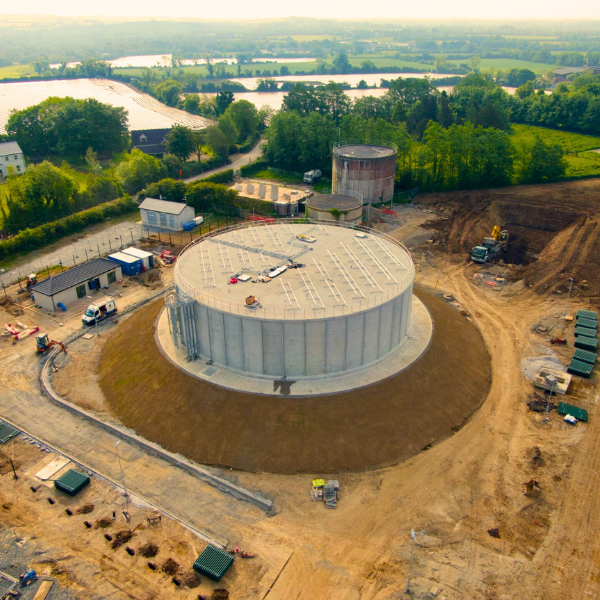The Limerick Urban Centre Revitalisation – O’Connell Street (LUCROC) Phase 1 project is a standout initiative in urban redevelopment, seamlessly blending modern urban needs with historical integrity. This transformative endeavour has reimagined O’Connell Street in Limerick City, turning it into a dynamic and inclusive urban space. By reducing traffic lane width and repurposing space for expanded pedestrian pathways, a dedicated bus lane, and innovative cycle tracks, Limerick Urban Centre Revitalisation – O’Connell Street (LUCROC) Phase 1 has significantly enhanced urban connectivity and liveability.
The introduction of street amenities such as seating, improved lighting, and green infrastructure, coupled with meticulous preservation of historical elements, underscores the project’s commitment to sustainable and culturally sensitive urban development. By prioritising sustainable transportation and enhancing public spaces, it has created an urban environment that balances functionality, aesthetics, and environmental responsibility. Its comprehensive approach in preserving heritage, engaging diverse stakeholders, and implementing cutting-edge urban design makes it an exemplary model for contemporary urban revitalisation projects.
Project Outline:
LUCROC Phase 1, focusing on the renovation of O’Connell Street from Denmark Street to Cecil Street in Limerick City, represents a significant leap in urban redevelopment. The project commenced in April 2021 and reached substantial completion in September 2023.
Encompassing a 6-block span, the project’s scope was expansive, incorporating four main blocks of O’Connell Street and extending to a minor segment south of Cecil Street for seamless integration. This also included an adjacent section, Thomas Street, enhancing the project’s reach and impact.The primary activities involved the removal of existing road surfaces, excavation, and installation of new service ducts and drainage systems. This was followed by laying protective concrete slabs and granite paving setts, which were used across the carriageway, cycleway, and pedestrian pathways. Additional enhancements included broader pavements, contemporary lighting, urban furniture, and an array of green infrastructure, further elevating the project’s scope and impact.
Technical Challenges, Innovative Solutions:
The LUCROC Phase 1 project encountered several unique challenges, notably managing the historical basements and vaults beneath O’Connell Street’s buildings. To mitigate this, Shareridge conducted comprehensive precondition surveys of all basements and accessible vaults. Special care was taken to preserve historic lightwells, metal grilles, and coal chutes, ensuring that these cultural treasures were protected throughout the renovation process. The project’s success in navigating these complex historical elements while integrating modern infrastructure demonstrates its innovative and sensitive approach
Another significant challenge was integrating various transportation modes into the busy urban fabric of Limerick City. To address this, a comprehensive Urban Traffic & Pedestrian Management Plan was developed and meticulously executed by Shareridge. This plan was instrumental in managing the flow of traffic, pedestrians, and cyclists, ensuring minimal disruptions to the city’s daily life. The plan’s effectiveness was further enhanced through close collaboration with local authorities, emergency services, and other stakeholders, underscoring the project’s commitment to community-centric development.
Innovative Use of Materials and Equipment:
In its quest to redefine urban design through innovation, the Limerick Urban Centre Revitalisation project embraced a diverse array of novel materials and advanced equipment. A cornerstone of this innovative approach was the selection of granite paving setts. Chosen for their exceptional durability and visual appeal, these setts replaced conventional paving materials to create an urban surface that was both visually striking and resilient, significantly enhancing the aesthetic and structural integrity of the streetscape.
Further augmenting the urban landscape, the project introduced a range of modern urban furniture. This included the installation of functional and stylish bollards, benches, bike stands, and waste bins. These elements not only improved the practicality and usability of the space but also added to the visual appeal of the street, contributing to an inviting and user-friendly public realm.
A standout feature of the project was the implementation of advanced lighting solutions. These were not just designed to improve visibility and enhance safety but were innovatively engineered to serve multiple functions. The street lights incorporated modular designs, enabling the integration of various additional features directly into the column body. This included an air pollution analysis module, adding an environmental monitoring function that is crucial in today’s urban settings. Additionally, these multifunctional lights featured, projection units, WiFi hotspots and charging stations, reflecting a deep understanding of the needs of a modern, connected society. These enhancements transformed the traditional concept of street lighting, making it a multifaceted tool that caters to the 24-hour requirements of contemporary city life.
Moreover, the project’s commitment to environmental sustainability and ecological balance was evident in the incorporation of features like rain gardens and APC units. These elements not only contributed to the aesthetic value of the urban landscape but also played a crucial role in promoting sustainability. Rain gardens, for instance, offered an effective solution for stormwater management, enhancing the area’s resilience to weather events, while APC units helped in maintaining cleaner air quality.
The thoughtful selection and application of these materials and technologies underscored the project’s dedication to blending innovation with sustainability. By doing so, the LUCROC Phase 1 project not only enhanced the functionality and beauty of the urban environment but also addressed key aspects of modern urban living, such as environmental sustainability, connectivity, and public health, making it a pioneering example of holistic urban redevelopment.
Health & Safety:
Health and safety were fundamental priorities throughout the entirety of the Limerick Urban Centre Revitalisation – O’Connell Street (LUCROC) Phase 1 project. The project’s strict adherence to the Health, Safety, and Welfare at Work Act 2006 was more than a regulatory obligation; it is a core value, ensuring a work environment that safeguarded everyone involved. The health and safety plan implemented was comprehensive and multifaceted, including regular audits and inspections that ensured all practices and equipment met or exceeded safety standards. Additionally, extensive worker training programs were conducted to equip the workforce with the knowledge and skills necessary to recognise and avoid potential hazards.
The implementation of industry best practices in construction safety was not merely a formality but a proactive measure to set new benchmarks in safety management. These practices included the use of advanced safety equipment, regular safety briefings, and the establishment of clear protocols for emergency situations.
This unwavering focus on health and safety extended beyond the protection of workers to include the public and other stakeholders. Safety measures were designed to ensure minimal disruption and risk to the surrounding community. For instance, construction areas were securely fenced off, and clear signage was provided to guide pedestrians and traffic safely around the site.
By minimising accidents and creating a secure working environment, the project was able to maintain a steady pace of progress, adhering to its timeline and quality standards. The team’s dedication to health and safety was also a key factor contributing to the project’s successful and timely completion.
Sustainability:
Sustainability was a key driver of the Limerick Urban Centre Revitalisation – O’Connell Street (LUCROC) Phase 1 project. The project team embraced sustainable practices at every stage, from design to execution. The promotion of pedestrian and cycling infrastructure was a significant step towards encouraging sustainable transport modes. The installation of rain gardens and efficient waste management strategies exemplified the project’s commitment to minimizing its environmental footprint.
The use of durable materials, such as granite setts, ensured the project’s longevity and reduced the need for frequent maintenance and replacements. The integration of environmental features, such as APC units, further demonstrated the project’s dedication to ecological balance and sustainability. These initiatives collectively contributed to creating a more sustainable and environmentally friendly urban space, aligning with broader goals of sustainable urban development.
Stakeholder Engagement:
Stakeholder engagement was a critical component of the Limerick Urban Centre Revitalisation – O’Connell Street (LUCROC) Phase 1 project. Shareridge’s Public Liaison Officer played a central role in maintaining open lines of communication with the community, local businesses, and utility providers. Regular meetings, updates, and consultations ensured all stakeholders were well-informed and had opportunities to provide input, ensuring the project’s alignment with community needs and expectations.
This proactive approach to stakeholder engagement was crucial in building trust and ensuring the project’s success. The team’s commitment to transparency and inclusivity fostered a positive relationship with the community, mitigating potential conflicts and facilitating smoother project execution. The engagement strategies employed by the project team set a high standard for future urban redevelopment initiatives, emphasising the importance of community involvement and collaboration. Such efforts ensured that the project not only met the needs of local residents and businesses but also fostered a sense of shared ownership and collaboration.
Community Impact:
The Limerick Urban Centre Revitalisation – O’Connell Street (LUCROC) Phase 1 project has had a transformative impact on the community in Limerick City. The creation of a more pedestrian-friendly and aesthetically pleasing environment has encouraged social interaction and community engagement, strengthening the bonds within the community. The project’s focus on inclusivity and accessibility has ensured that it benefits a wide range of users, enhancing the overall quality of life in the city.
The project’s impact on the community extends beyond physical improvements. By enhancing urban mobility and safety, and enriching the street’s aesthetics, it has revitalised the heart of Limerick City. These improvements have not only made the area more accessible and enjoyable but have also fostered a renewed sense of community pride and connection. The project’s contribution to the city’s cultural and social fabric is significant, enhancing the quality of life for residents and visitors alike.
Time and Cost Management:
The on-time and within-budget completion of the Limerick Urban Centre Revitalisation – O’Connell Street (LUCROC) Phase 1 project stands as a clear demonstration of outstanding project management capabilities.
This success was achieved through meticulous planning, efficient resource allocation, and adaptive execution strategies. Regular progress assessments and proactive adjustments were key in ensuring that the project met its financial and time-based objectives, demonstrating a high level of competency in managing complex urban redevelopment projects.
The project team’s ability to navigate unforeseen challenges, adapt to changing circumstances, and maintain a focus on the end goal was crucial in delivering the project on time and within budget. This disciplined approach to time and cost management ensured that resources were utilised efficiently, maximizing the project’s value and impact.
The project team’s ability to efficiently manage both time and financial resources ensured the project’s success, setting a benchmark for future urban development projects.





